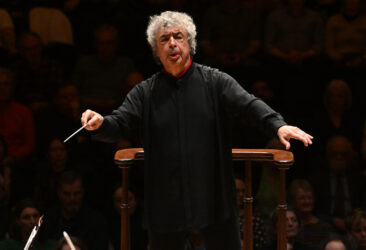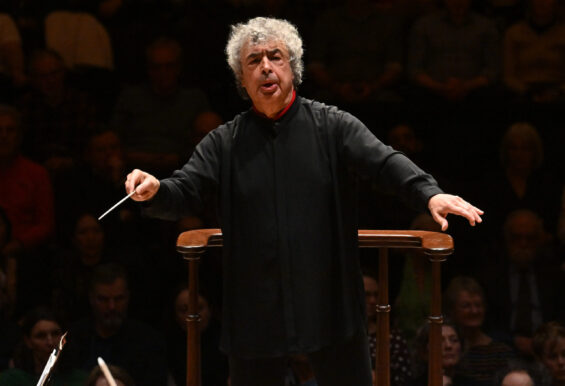 United Kingdom Shostakovich: Sheku Kanneh-Mason (Cello) Czech Philharmonic Orchestra / Semyon Bychkov (conductor). Barbican Hall, London, 7.3. 2025. (CSa)
United Kingdom Shostakovich: Sheku Kanneh-Mason (Cello) Czech Philharmonic Orchestra / Semyon Bychkov (conductor). Barbican Hall, London, 7.3. 2025. (CSa)

Shostakovich – Cello Concerto No.1; Symphony No.5 in D minor
Dmitri Shostakovich, one of the most prominent and complex musical figures of the twentieth century, died in Moscow in August 1975. He was 68 years old. Described variously as a proud nationalist, disillusioned conformist and covert dissident, he defied censorship, threats of banishment and death, while navigating the perilous political landscape of Stalinist Russia with ingenuity, courage and integrity. In the words of his biographer Elizabeth Wilson, ‘Shostakovich had to wear a mask, but behind that mask, he found ways to express the truth.’
The Barbican marked the 50th anniversary of Shostakovich’s death in a concert given by the Czech Philharmonic Orchestra under its distinguished chief conductor, Russian born Semyon Bychkov.
Informed by the dark history of life under Soviet occupation, there are few orchestras better able to understand the historical and political context of Shostakovich’s work and to express the subtle ambiguity of his harmonic language. Equally, there are no conductors better qualified to interpret it. For political reasons, Bychkov fled to the USA, just two years after the composer’s death. Although he did not live through the years of mass terror in the Soviet Union, he understands the way of life experienced by Shostakovich and has frequently claimed to identify with it.
The programme consisted of two of Shostakovich’s greatest and most enduring works. His mighty Fifth Symphony – subversively entitled A Soviet Artist’s Response to Justified Criticism – was written in 1936 after official denunciation following the popular success of his opera Lady Macbeth of the Mtensk District.
The concert began however with the sardonic and defiant First Cello Concerto, which the composer wrote in 1959 for the legendary Mstislav Rostropovich. Coated with a thin layer of ‘Soviet realism’, Shostakovich managed to produce a popular masterpiece while protecting himself from the ‘anti-formalist’ witch hunt of the Soviet authorities, still raging six years after Stalin’s death. In Bychkov’s performance the paired down orchestra was joined by the young and internationally acclaimed British cellist Sheku Kanneh-Mason whose musical stature and authority have grown considerably since his star appearance at the Sussex wedding in St George’s Chapel, Windsor in 2018. In a display of matchless virtuosity, he made light of the concerto’s huge technical demands.
The ferocious opening Allegretto – which Shostakovich described as ‘a jocular march’, and which referenced an earlier composition depicting young Soviet soldiers being sent to their deaths by the Nazis – was played on the cello with anxious intensity, and driven by shrill recurring blasts from a single horn, plaintive woodwinds, and gunfire bursts of timpani. In the second movement Moderato, the cello and horn, underscored by lush vibrant strings, sang together in a haunting and tender lament, evolving into an intimate solo cadenza. Here Kanneh-Mason balanced passages of fierce passion and mounting agitation with moments of tender vulnerability. The finale, a cruel and joyless dance which distorted one of Stalin’s favourite folk songs, was tautly executed and explosively concluded with a mocking sneer from the horn. In an acknowledgment to thunderous applause, Kanneh-Mason offered the capacity audience a very different dance – a slow and expressive Sarabande from Bach’s Cello Suite No.2 in D minor.

Symphony No.5 occupied the second half. With Kanneh-Mason and the cellist’s podium gone, one had a better opportunity to study Bychkov’s remarkable technique. Combining precision and intensity, he used a baton sparingly, frequently relying on expressive hand and wrist movements to shape and mould dynamic shifts and phrasing, and to coax from the players textures of astonishing subtlety. He exerted control where necessary but never dominated, allowing his musicians moments of spontaneity in emotionally charged passages. Above all, he appeared to respect and inspire them. The result was transcendent. The dramatic introductory chords of the symphony’s first movement were full of foreboding while the gentle melody that followed brimmed with sadness. Yet another grotesque march – an essential satirical weapon in Shostakovich’s musical armoury – goosestepped its way through the movement but ended with an elegiac violin solo, sweetly played by the orchestra’s leader Jan Fišer.
The second movement Allegretto – with its raucous horns, delicate passages for harp violin and cello and trio for strings, flute and bassoon – were realised with clarity and precision, and magnificently contrasted with the swelling melancholy of the strings in the third movement, a tragic Largo.
The symphony ended with a no-holds barred rendition of the dystopian Allegro non troppo. ‘It’s as if someone were beating you with a stick and saying “Your business is rejoicing” …and you rise, shaky, and go marching off, muttering “our business is rejoicing…”’ wrote Shostakovich in his memoirs Testimony. 50 years after his death, in an era of growing oppression around the world, the need to defy tyranny and speak truth to power is greater than ever. It makes Shostakovich’s music as timely and relevant now as it was when he wrote it. This fact was not lost on Bychkov and his Czech players. Their encore – Elgar’s Nimrod – was a stirring benediction, a tribute to democracy, and a touching thank you to their British friends.
Chris Sallon
